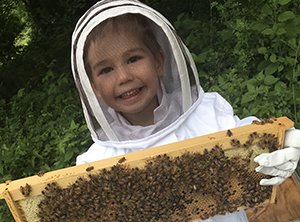
Three-year-old beekeeper
Three-year-old Gary is proud of his hive!
Susanne Cooper (Grandmother)
Nashville, Tennessee
Breeding treatment-free bees
We are so grateful to see Randy Oliver’s post; especially after almost ALL of our speakers at our annual Buzz in N.E. Oklahoma have been telling us to develop our own local survivor bees. We had been taught in 2000 that we HAD to use chemicals to keep varroa in check. By 2002, we went cold turkey, incorporated the screened bottom board and IPM methods culling hives down to just 2 who met our stringent requirements. Recently we also joined CNGfarming/Apiary which allows Oxalic Acid by monitoring and doing just what Randy suggested and has done for 2 years!
So, since 2002, we only raise our own queens the old fashioned way from making splits, minimal sugar water feeds and instead working on bee forage. What a DELIGHT to read how Randy’s crew is having FUN again working with bees that are natural SURVIVORS. We love Randy’s DEDICATION to documentation and monitoring! This way natural beekeepers can also learn and share this genetics with others as we do. Our 17 year strain(s) include a mixture of Carnolians, Italian (less so) and a Russian strain from the NM Rojas Project about 5 years ago. We have searched and obtained 2 more 4-7 yr non treated hives which survived without chemicals from other beekeepers to add to our own gene pool.
Randy is demonstrating what our local club told us COULDN’T BE DONE 18 years ago! (we already know AND DID!). We sell only a couple of nucs to new beekeepers each spring who are interested in more natural beekeeping methods and MENTOR them. Last year, we overwintered with only honey frames from our then 20 hives. Four were one brood/one super w 4-6 honey in frames (ALL SURVIVED). We need to follow through with MORE confirmation that hobbyists CAN and DO PROVIDE BEES THAT HAVE DEVELOPED NATURAL RESISTANCE/HYGENIC BEHAVIOR AGAINST VARROA. We have also increased forage for our bees from February to Frost (late Oct) for Oklahoma.
The problem? Breeders/Researchers need to contact and obtain some of these survivor strains from hobby beekeepers around the country who are already proven including Randy’s strains he found. Breeders could then raise queens from MULTIPLE AREAS using strains which are healthier and hardier, instead of artificially inseminated queens from a low gene pool! Randy Oliver is ON THE RIGHT TRACK! Guess what? It’s NOT about selling anything. Most of us would donate a hive to a project! We would like to see a project comparing sugar “roll” vs 24 hr mite drops (or averages/24 hrs), as we do NOT kill bees testing for mites. We worked on survivability FIRST then honey production and gentleness last. We even mentored one fellow in another town who is doing the same with his BUCKFAST strain from Weaver in TX. He only culls a queen now if her hive gets too “angry.” :)) WE CAN’T WAIT TO READ ARTICLES FROM RANDY OLIVER!
Mack and Helen Hickey,
Sand Springs, Oklahoma
Works of Creator Continue to Amaze
In the June 2019 edition of the American Bee Journal there is an article on page 620 entitled “Israeli Scientists find a flower they say can hear approaching bees.” I found this short news article very exciting. To think that when God designed the flowers and the bees, he would include this ability for a flower to hear the approach of the pollinators and then to “produce extra and sweeter nectar in response” causes me to pause and say WOW. The Creator of this world in which we live continues to amaze us as we learn more about how it has been put together. Thank you for sharing this article and for all the hard work in putting the American Bee Journal together each month.
Gordon Goeking
BeeKeeper in
Raleigh, North Carolina
Editor Response
Thanks, Gordon. I also found this fascinating, and it will be interesting to see if other researchers are able to duplicate their findings. And I’m with you — it seems the more closely we delve into the world around us, the more incredible it all becomes.
Eugene
Ligurian Bees
Greetings Mr. Campbell,
I am just now completing your article, which I scanned but enjoyed immensely. The romantic in me is pretty strong and the idea of tending such a bee as the Ligurian has captured my mind! Thanks for introducing.
So, from your article I take it there is, currently, no way to import?
Wayne Hunsucker
From Glenn
Hi Wayne,
Glad you enjoyed the article. I discovered I could not import the Dark Italian Ligurian Queen back in the early 1970›s when I was a very young man.
I was an American soldier and the Italian authorities would not let me ship dark Italian queens home to Tennessee from Italy. In 1922 the U.S. forbade the import of bees due to the acarine/tracheal mite epidemic of Europe that almost totally wiped out the English Black Bee. The Dark Italian mixed with the Old Black English Bee saved some of the genetics. This hybrid cross of dark Ligurian Alps Italian and English honeybees are the two foundation stocks of the Buckfast Bees developed by brother Adam.
My motives with this article are to (1) generate a lot of interest in the Dark Italian Ligurian bee and (2) then convince the ….


